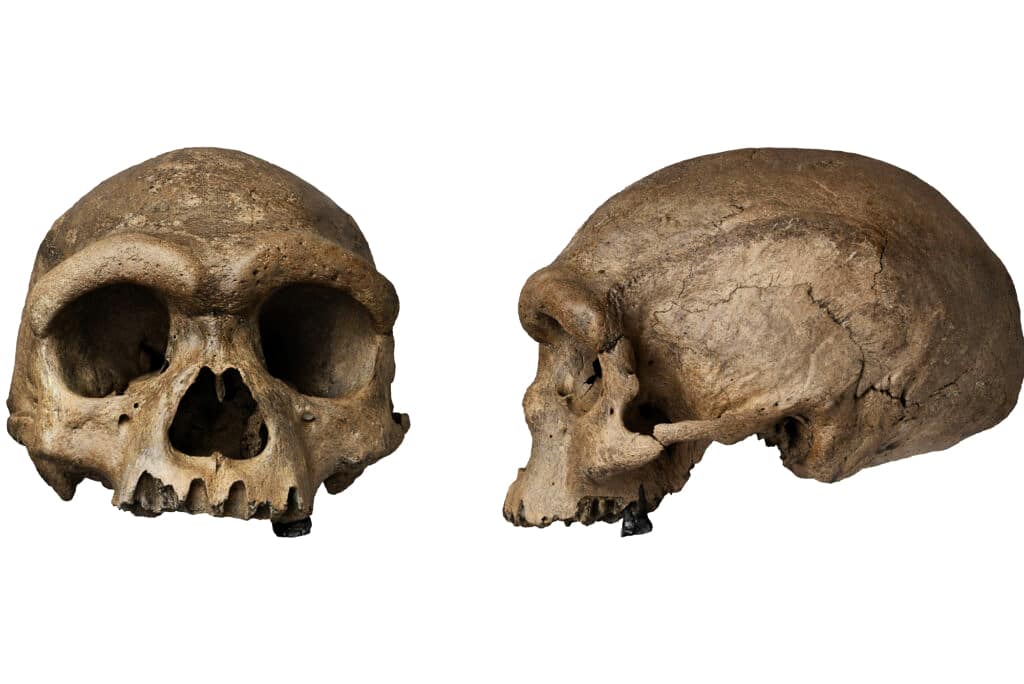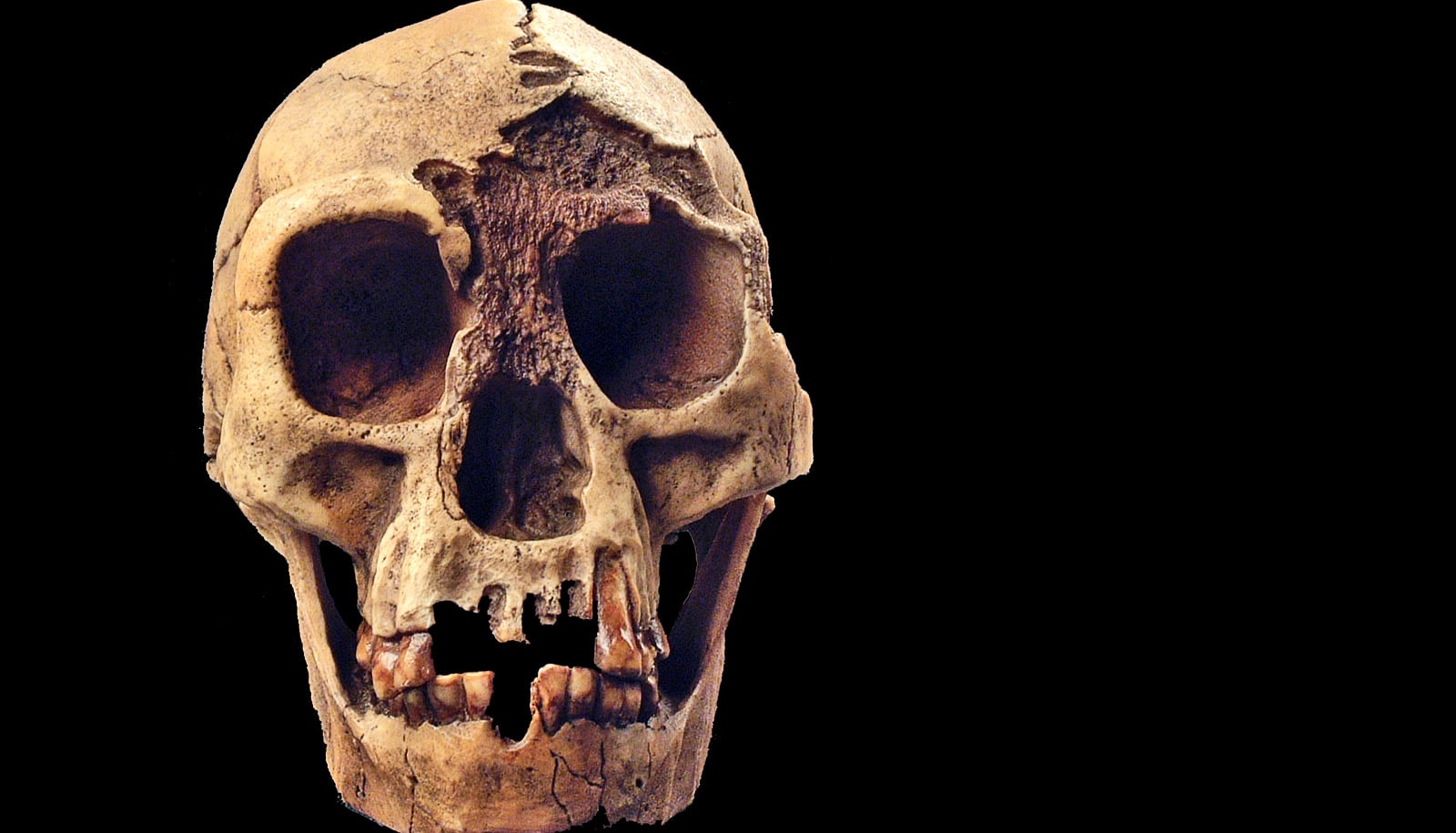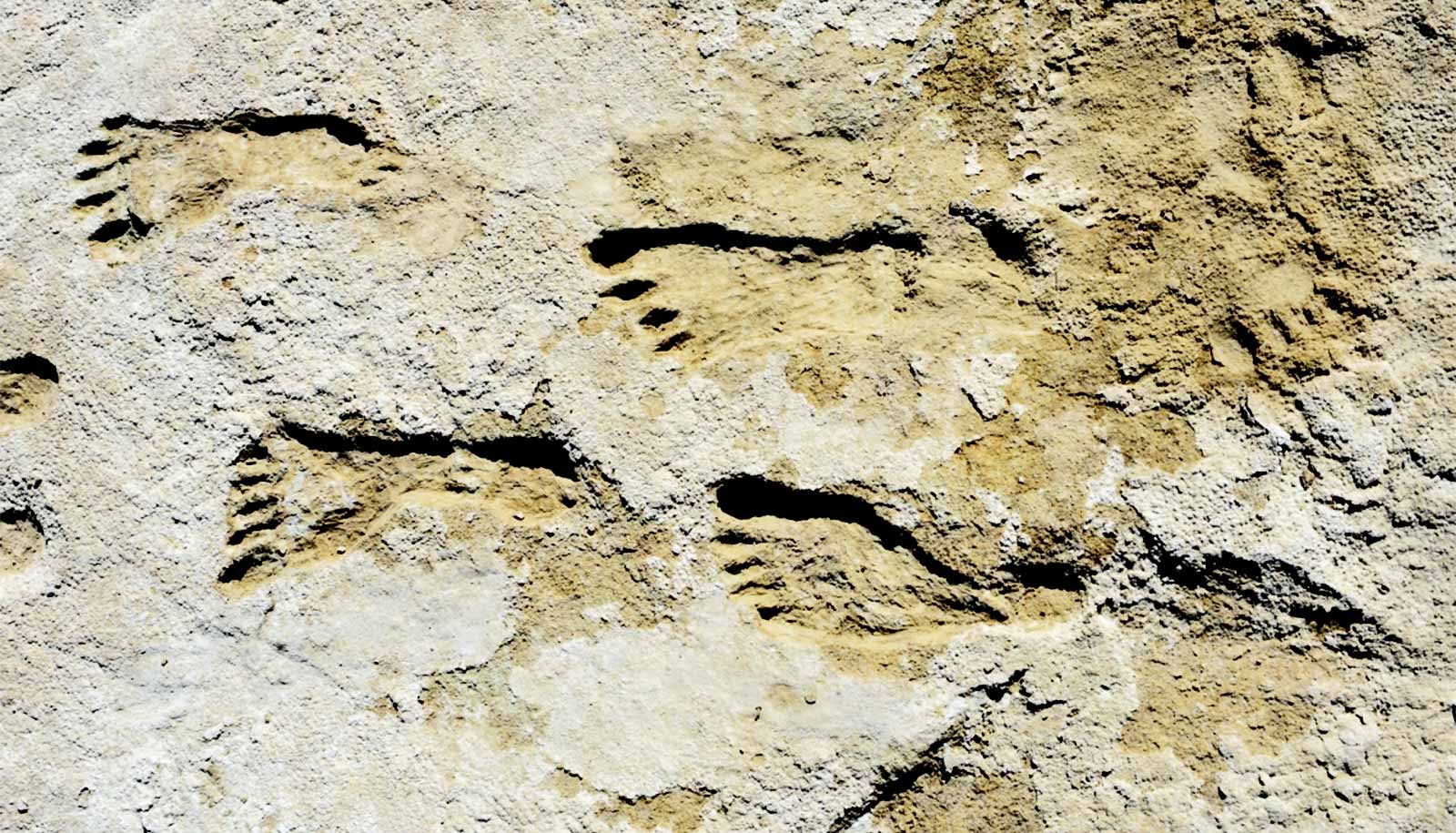
The newly-discovered, massive fossilized cranium provides tantalizing clues into what humans looked like at that time, a period in East Asia in which there has been a gap in the human fossil record. (Credit: The Innovation/ Cell Press )
‘Dragon Man’ may be a missing link in human evolution
Dragon Man's 140,000-year-old fossilized skull may reveal new clues about the transition between our earlier ancestors and modern humans.
The “Dragon Man” skull provides clues as to what humans looked like some 140,000 years ago, a period in East Asia in which there has been a gap in the human fossil record.
Every so often, the fossilized discovery of a previously unknown human ancestor sends ripples around the world, as anthropologists and the public are mesmerized by a new window into the story of us. Will we learn more about how we came to be and who we are today, or what life was like for those who lived thousands or even hundreds of thousands of years ago?
The latest discovery, announced in June, is a skull found near China’s Dragon River that dates back to more than 140,000 years.
The large, long skull, belonging to an adult male with a robust brow line, had been hidden in a well by a Chinese man who found it in 1933 while doing construction work under occupation by the Japanese. Instead of telling Japanese officials about the skull, the laborer tucked it safely away, never speaking of it until divulging the secret to his family shortly before his death in 2018.
The researchers who first analyzed and described the new specimen in three papers published in Cell have named its species Homo longi , nicknamed “Dragon Man,” for the region of northeastern China where it was found.
How will the discovery of Dragon Man help us better understand human evolutionary history ? What was his life like? And why are there so few human fossils from his time and region of the world?
Here, Christopher Schmitt , an assistant professor of anthropology and biology at Boston University and an expert in evolutionary biology and paleogenomics, explains why Dragon Man’s skull is so significant:
The post ‘Dragon Man’ may be a missing link in human evolution appeared first on Futurity .
What makes the discovery of Dragon Man so interesting?
East Asian paleoanthropology was set back during World War II, during which time a lot of specimens were either lost or destroyed. The fossil record for East Asia during Dragon Man’s time has long been a mystery for Western academics, not readily accessible to the rest of the world. So these findings are really, really exciting.
The researchers who analyzed the skull believe it is one of the earliest humans. What do you think of their analysis?
Their analysis is interesting—it’s definitely adding more to our knowledge of the region and of human evolutionary history. My expertise is more in paleogenomics , or using genetic analysis of the fossil record to infer characteristics and lineage of human ancestors. To me, one thing that’s really fascinating about this skull [which is missing its lower jaw] is that the researchers also talked about its similarity to a mandible—known as the Xiahe specimen—that has been argued to be from a Denisovan.
Who or what were the Denisovans?
The Denisovans are a sister lineage to the Neanderthals, which we only really know about from genomic data. The oldest evidence of Denisovans was discovered in Spain, in the genome of a hominin specimen at Sima de los Huesos [“Pit of Bones”], dating back to 430,000 years ago. DNA from this specimen’s cell nuclei looks Neanderthal, but its mitochondrial DNA looks Denisovan. This, along with other genomic analyses, suggests that the Neanderthals and Denisovans split very early on in Europe. Then, both Neanderthals and Denisovans mated with humans migrating out of Africa.
All of the specimens from East Asian in the Middle Pleistocene [from 770,000 to 126,000 years ago]—it’s possible that they all represent interbreeding. The people represented by Dragon Man likely didn’t disappear, but rather continued breeding with other early humans. Present-day humans in parts of East and Southeast Asia still have between 2 and 6% Denisovan DNA.
If the skull is Denisovan, what will that tell us about our evolutionary history?
Although the researchers are leaning toward this being a basal human, it’s much more interesting—to me, at least—to think that this could be a Denisovan. We won’t know that for sure until—and if—they can get genomic data from the skull. But until now, there’s been no face to put to the Denisovans—so far, the only skeletal materials we’ve discovered that are definitely Denisovan are a tooth and the little tip of a pinky finger—and potentially the Xiahe mandible.
So, if this turned out to be a Denisovan, that would be really exciting—this could be the first cranial specimen. The fact that Dragon Man looks like a lot of other East Asian specimens—like a famous skull known as the Dali skull—means this could be another piece of the puzzle, both a clue as to why these Middle Pleistocene East Asian specimens have been so hard to place in the human fossil record, and a rich source of understanding what Denisovans might have looked like.
Now that the skull has been discovered and an initial analysis has been performed and reported, what would you like to see happen next?
What comes next really depends on how well the skull is preserved. To get genomic data, we’d need to take a small piece of that skull, grind it up, and sequence it for DNA in a very carefully controlled setting to make sure the sample isn’t contaminated with DNA from contemporary humans.
At 146,000 years old, it’s theoretically possible to get DNA out of it. If it was in a relatively warm, wet area, however, there might be less DNA preserved. But the original discovery of Denisovan DNA came from the fossil record—that tooth and pinky finger I mentioned—so I’m very optimistic that it’s possible.
Having a full cranium is amazing, and I’m really happy they posted so many images of it so we can see what it looks like. At this point, paleoanthropologists have only just taken the first step of characterizing how this individual fits into human history.
How might Dragon Man fit into that picture, given the initial characterization?
Looking at the Middle Pleistocene human ancestor fossil record, there’s a lot of work to be done there. We don’t have a clear idea of what happened evolutionarily between the time of Homo erectus and Homo sapiens , and Dragon Man falls right into the middle of this period. This is a time when we see a lot of mosaic variation—with different combinations of Homo sapien and Homo erectus traits—in hominin remains throughout Africa, Europe, and Asia, making it difficult to see a clear transition from one species to the next.
Among these, Middle Pleistocene East Asian humans have been some of the most difficult to characterize, and Dragon Man adds to the story by giving us more of an idea of what early people in this region looked like at that time. We’re only seeing brief glimpses, though, [with fossils being found scattered across huge swaths of time].
The idea that Homo erectus is something completely different from us is an artifact of needing to name this older group of specimens that look slightly different from contemporary humans. But they are definitely our immediate ancestors.
Looking at this transitional period of Middle Pleistocene humans, which Dragon Man falls into, can give us a better idea of when we evolved the cranial traits that we associate with our becoming Homo sapiens, and also how much regional variation plays a role in the differences we see in the fossil record.
We had early humans living in very different ecologies in very different parts of the world during the Middle Pleistocene, which can produce different superficial features, just like we see in contemporary human populations today.
You say that Homo erectus , long thought to be a different, earlier species of human ancestor, might even be an example of an early human instead of a different species. From an archaeologist’s perspective, where does one species end and another species begin?
This is something I teach in my human behavioral biology and evolution course—the idea of classifying species is that it’s a model for understanding variation in organisms, grouping together individual animals that collectively have extremely similar traits.
There are a lot of ways to make these groupings. One way—the biological species construct—is to say that to be a member of the same species, you have to be able to reproduce. From that perspective, we would have to say that Denisovans and Neanderthals are also humans, because we know they mated with each other and with Homo sapiens —4% of my own genome, for example, is Neanderthal.
The idea of a species can be somewhat nebulous, however, when you’re thinking about the long and slow transition from Homo erectus to Middle Pleistocene humans to the earliest modern humans that arose around 200,000 years ago to present-day humans. It’s a question of small gradients of change in regions, and whether we can put a boundary on those gradients that’s biologically or evolutionarily meaningful.
Looking at Middle Pleistocene humans and their mosaics of Homo erectus and Homo sapien traits, along with regionally distinct traits, we’re grappling with whether these populations show enough substantial differences from our current form to be considered something different from us—in their peer-reviewed papers, these researchers are saying that Dragon Man looks like he fits closer to the category of Homo sapiens than Neanderthals or Denisovans, but that he may represent a unique sister lineage to Homo sapiens , [which they are calling Homo longi ].
Given what we know about Dragon Man and other hominins of that time period, what do you think his life might have been like? Looking at his cranium, does that tell us about how intelligent he would have been?
When talking about intelligence, variation in brain size means nothing among present-day humans—it doesn’t have any impact on intelligence at all. Neanderthals, for example, had bigger brains on average than Homo sapiens , but that doesn’t mean they were smarter. One of the long-standing questions paleoanthropologists have been trying to answer is could Neanderthals use language? For a long time, we thought they couldn’t. But then we sequenced their genome, and discovered they have a version of the FOXP2 gene that facilitates speech in present-day humans. So it’s possible they spoke.
I would argue the same for Dragon Man—there’s no reason to doubt the people he represents were any more or less intelligent than contemporary humans based on their cranial size. But without archaeological evidence of culture, we can’t know how similar or different their lives were from ours.
What might have Dragon Man’s family structure been like? Or how do you think he might have spent his time—did he daydream or make art for personal or cultural expression?
From the Middle Pleistocene, we have the archaeological record that tells us humans at that time fairly certainly had tools. If they had tools , they probably had culture, because to make tools you generally need to learn those skills socially and pass those skills on to others. It’s unlikely they had agriculture, since we only see evidence of that pop up in the archaeological record 10,000 to 15,000 years ago, nor is it likely they made art, given we generally don’t see that until around 45,000 years later.
Dragon Man likely lived in a small band of hunter-gatherers, with a family or with multiple families living together. It’s really difficult to say what those family groups looked like. Were there bonded pairs of mates, or polyamorous groupings? Were they egalitarian? We’d really need to get more artifacts of material culture from that area to answer some of these questions.
One of the most fascinating things about the discovery of Dragon Man is that it was found at the bottom of a well after being hidden there nearly 80 years ago. Is this as unusual as it seems to me, or is this sort of treasure stashing something that archaeologists often come across?
This is actually fairly common—you read about [specimen] caching in a number of cases. We see archaeologists come into an area, collect a bunch of specimens, and then they go into a drawer, waiting for a graduate student or contract archaeologist to catalog and analyze them. Maybe whoever has them in their possession is interested in something else, and they have lots of specimens to choose from studying, so a lot of times these groundbreaking finds are just waiting for someone to realize what they are.
And sometimes a specimen is held back from the public at the will of a researcher. [An earlier human ancestor called] Ardipithecus ramidus , for example, was discovered in the mid to late 1990s, but was not published in scientific literature until 15 or 20 years later.
In this case, Dragon Man was hidden at the bottom of a well to keep it from [being taken] by occupying forces, and political instability in that region at the time led to people not picking up on its presence until the family of the discoverer brought it to the attention of researchers.
Share this article:
This article uses material from the Futurity article, and is licenced under a CC BY-SA 4.0 International License. Images, videos and audio are available under their respective licenses.


